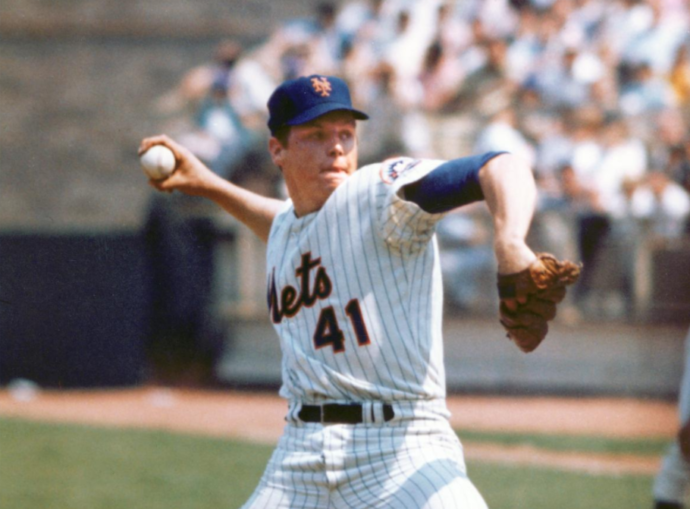
Five-and-two-thirds innings into his outing against the San Diego Padres at Shea Stadium on April 22, 1970, Tom Seaver had faced 22 batters. Two managed hits and nine struck out. For an ordinary pitcher, it would be a great day. For Seaver, who in three seasons had established himself as arguably the best at his position, it was any other day.
Seaver would eventually deliver a performance befitting of the Cy Young Award he received prior to the game. Then he took it to new heights. We often hear of a pitcher being untouchable. In Seaver’s case, specifically for the last 3 1/3 innings, this was no overstatement.
During that span, nobody reached base. Nobody put the ball in play. When Seaver got Al Ferrara swinging to end the ninth, it was an exclamation point on one of the most brilliant chapters of his Mets career. The 19 strikeouts tied a major league record at the time. The 10 strikeouts in a row is a record that went unmatched for over half a century. And the fact that those ten concluded the game only elevates the feat.
“I might as well have played without a glove,” said Bud Harrelson. That wasn’t an exaggeration. The Gold Glove shortstop never saw a ball come within his reach all day. Harrelson was able to help out with a third-inning triple that delivered a go-ahead run and a slim 2-1 lead.
Seaver refused to give the Padres – a club in its second season of existence – any idea of a threat. Ferrara was the only Padre to give Seaver any trouble. He led off the second with a tying home run and drew a walk in the top of the fourth. Dave Campbell followed with a two-out single.
Campbell’s hit was the second and final one for San Diego. When Cito Gaston flew out to Art Shamsky in right, no one knew there would be no more fair balls from the Padres lineup.
Seaver avenged his earlier struggles with Ferrara by getting him on a swinging strike three to end the sixth. He breezed through the seventh by fanning Nate Colbert, Campbell, and Jerry Morales. He did the same in the eighth, punching out Bob Barton, Ray Webster, and Ivan Murrell to surpass Nolan Ryan’s franchise single-game record of 15 K’s – which lasted all of four days.
The paid crowd of only 14,197 generated a noise that made Shea feel as if it was at capacity. It got louder as Seaver swiftly dispensed with his ninth-inning opponents. First, Van Kelly – down on three successive fastballs. Then, Gaston – caught looking.
Only Ferrara stood in Tom’s way. On top of the Mets’ single-game record, Seaver had already set the mark for most consecutive strikeouts and tied the mark for most K’s in a nine-inning day game, while just one away from matching Carlton’s magical 19.
Preserving the one-run lead while facing the man responsible for the Padres’ only score, the margin for error remained small.
He used a pair of sliders and a fastball to bring the count to 1-2. Up to this point, Seaver had thrown 135 pitches, 95 for strikes. Eighty of those pitches were fastballs. Sixty-four of those fastballs were strikes. Seaver, with a mind as brilliant as anyone who ever took the mound, understood that he had to go with his best – even if it meant using the pitch Ferrara took deep earlier in the game.
There are many methods by which to measure pitching greatness. The handful who’ve thrown perfect games and the select pitchers – Seaver included among them – who’ve tossed no-hitters have their deserved spot in baseball history. But what Seaver accomplished against the Padres is uniquely his.















